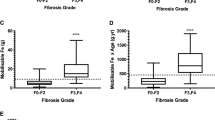Abstract
Objective
To assess the accuracy of quantification of liver iron concentration (LIC) by MRI using the Rennes University (URennes) algorithm.
Methods
In the overall study period 1999–2006 the LIC in 171 patients was calculated with the URennes model and the results were compared with LIC measured by liver biopsy.
Results
The biopsy showed that 107 patients had no overload, 38 moderate overload and 26 high overload. The correlation between MRI and biopsy was r = 0.86. MRI correctly classified 105 patients according to the various levels of LIC. Diagnostic accuracy was 61.4%, with a tendency to overestimate overload: 43% of patients with no overload were diagnosed as having overload, and 44.7% of patients with moderate overload were diagnosed as having high overload. The sensitivity of the URennes method for high overload was 92.3%, and the specificity for the absence of overload was 57.0%. MRI values greater than 170 μmol Fe/g revealed a positive predictive value (PPV) for haemochromatosis of 100% (n = 18); concentrations below 60 μmol Fe/g had a negative predictive value (NPV) of 100% for haemochromatosis (n = 101). The diagnosis in 44 patients with intermediate values remained uncertain.
Conclusions
The assessment of LIC with the URennes method was useful in 74.3% of the patients to rule out or to diagnose high iron overload. The method has a tendency to overestimate overload, which limits its diagnostic performance.




Similar content being viewed by others
References
Brittenham GM, Badman DG (2003) Non invasive measurement of iron: report of an NIDDK workshop. Blood 101:15–19. doi:10.1182/blood-2002-06-1723
Alustiza JM, Castiella A, De Juan MD et al (2007) Iron overload in the liver diagnostic and quantification. Eur J Radiol 61:499–506. doi:10.1016/j.ejrad.2006.11.012
Gandon Y, Olivié D, Guyader D et al (2004) Non-invasive assessment of hepatic iron stores by MRI. Lancet 363:357–362. doi:10.1016/S0140-6736(04)15436-6
Gandon Y (2010) Iron and liver. http://www.radio.univ-rennes1.fr. Accessed 17 Mar 2010
Olthof AW, Sijens PE, Kreeftenberg HG, Kappert P, van der Jagt EJ, Ouderk M (2009) Non-invasive liver iron concentration measurement by MRI: comparison of two validated protocols. Eur J Radiol 71:116–121. doi:10.1016/j.ejrad.2008.02.008
Olthof AW, Sijens PE, Kreeftenberg HG et al (2007) Correlation between serum ferritin levels and liver iron concentration determined by MR imaging: impact of hematologic disease and inflammation. Magn Reson Imaging 25:228–231. doi:10.1016/j.mri.2006.09.019
Pietrangelo A, Corradini E, Ferrara F et al (2006) Magnetic resonance imaging to identify classic and nonclassic forms of ferroportin disease. Blood Cells Mol Dis 37:192–196. doi:10.1016/j.bcmd.2006.08.007
Christoforidis A, Perifanis V, Spanos G et al (2009) MRI assessment of liver iron content in thalassamic patients with three different protocols: comparisons and correlations. Eur J Hematol 82:388–392. doi:10.1111/j.1600-0609.2009.01223.x
Alústiza JM, Artetxe J, Castiella A et al (2004) MR quantification of hepatic iron concentration. Radiology 230:479–484. doi:10.1148/radiol.2302020820
Alustiza Echeverria JM, Castiella Eguzkiza A, Zapata Morcillo E, Jauregui Garmendia L, Gabilondo Aguiregabiria A, Paloc C (2008) Quantification of liver iron concentration using 1-Tesla MRI. Radiologia 50:303–307
Costero Pastor B, Díez Pérez-Vacas MI, Mendez A et al (2007) Correlación de las pruebas y técnicas de imagen con la sobrecarga de hierro hepática en las hepatopatías crónicas. Rev Esp Enferm Dig 99(Suppl I):80
Rose C, Vandevenne P, Bourgeois E, Cambier N, Ernst O (2007) Liver iron content assessment by routine and simple magnetic resonance imaging procedure in highly transfused patients. Eur J Haematol 77:145–149. doi:10.1111/j.0902-4441.2006.t01-1-EJH2571.x
Guyader D, Gandon Y (2000) Quantification of iron overload. Bull Acad Natl Med 184:337–348
Porter JB, Davis BA (2002) Monitoring chelation therapy to achieve optimal outcome in the treatment of thalassaemia. Best Pract Res Clin Haematol 15:329–368. doi:10.1053.beha.2002.0214
Wood JC, Enriquez C et al (2005) MRI R2 and R2* mapping accurately estimates hepatic iron concentration in transfusion-dependent thalassemia and sickle cell disease patients. Blood 106:1460–1465. doi:10.1182/blood-2004-10-3982
Argyropoulou MI, Astrakas L (2007) MRI evaluation of tissue iron burden in patients with β-thalassaemia major. Pediatr Radiol 37:1191–1200. doi:10.1007/s00247-007-0567-1
Chavhan GB, Babyn PS, Thomas B, Shroff MM, Haacke EM (2009) Principles, techniques, and applications of T2*-based MR imaging and its special applications. Radiographics 29:1443–1449. doi:10.1148/rg.295095034
Wood JC (2009) History and current impact of cardiac magnetic resonance imaging on the management of iron overload. Circulation 120:1961–1968. doi:10.1161/CIRCULATIONAHA.109.907196
Villeneuve JP, Bilofdeau M, Lepage R et al (1996) Variability in hepatic iron concentration measurement from needle-biopsy specimens. J Hepatol 25:172–177. doi:10.1016/S0168-8278(96)80070-5
Crisponi G, Ambu R, Cristiani F et al (2000) Does iron concentration in a liver needle biopsy accurately reflect hepatic iron burden in beta-thalassemia? Clin Chem 46:1185–1188
Emond MJ, Bronner MP, Carlson TH et al (1999) Quantitative study of the variability of hepatic iron concentrations. Clin Chem 45:340–346
Kreeftenberg HG, Koopman BJ, Huizenga JR et al (1984) Measurement of iron in liver biopsies–a comparison of three analytical methods. Clin Chim Acta 144:255–262. doi:10.1016/0009-8981(84)90061-5
Kim MJ, Mitchell DG, Ito K, Hann HW, Park YN, Kim PN (2001) Hepatic iron deposition on MR imaging in patients with chronic liver disease: correlation with serial serum ferritin concentration. Abdom Imaging 26:149–156. doi:10.1007/s002610000121
Author information
Authors and Affiliations
Corresponding author
Rights and permissions
About this article
Cite this article
Castiella, A., Alústiza, J.M., Emparanza, J.I. et al. Liver iron concentration quantification by MRI: are recommended protocols accurate enough for clinical practice?. Eur Radiol 21, 137–141 (2011). https://doi.org/10.1007/s00330-010-1899-z
Received:
Revised:
Accepted:
Published:
Issue Date:
DOI: https://doi.org/10.1007/s00330-010-1899-z




